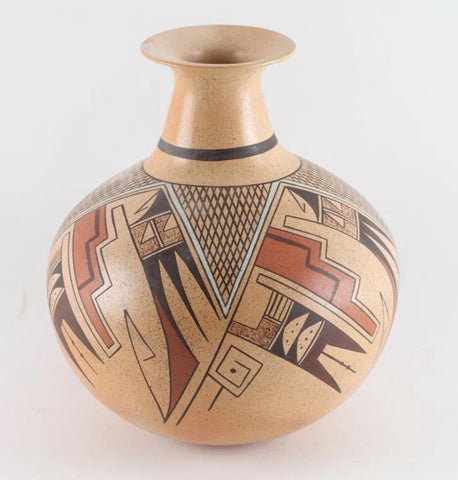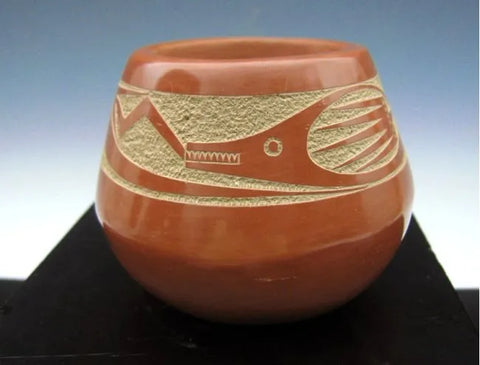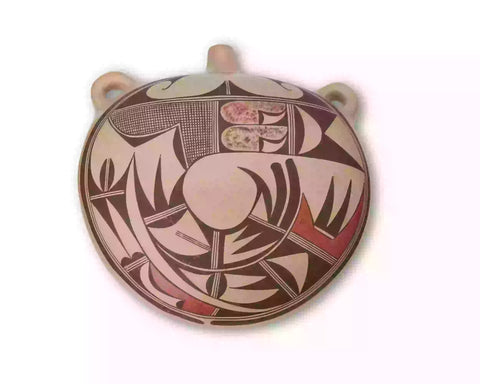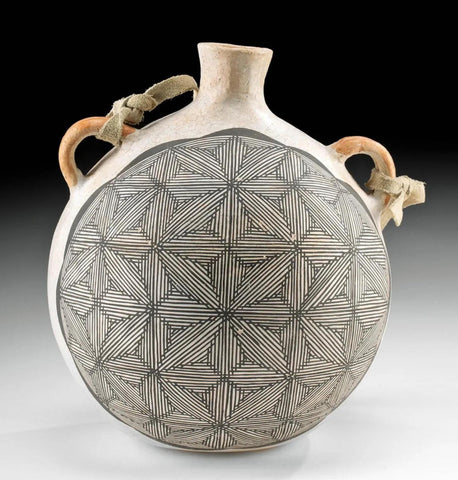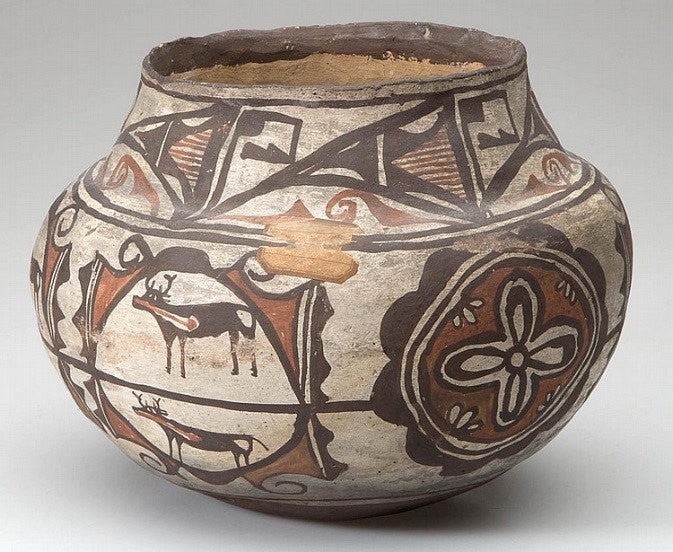
Native American Zuni Pottery Olla #33 Sold
$ 4,575.00
Native American
Zuni Pottery
33. NATIVE AMERICAN ZUNI POTTERY OLLA, polychrome on white, decorated with a wide geometric border, the body painted with multiple "deer house" motifs alternating with stylized blossoms. Condition Report: Very good condition, with typical wear. Provenance: Collection of the late John and Lil Palmer, Purcellville, VA. Ex-collection of Leonard Landis, Harman, WV.
Dimensions: 7" H, 9" DOA. Date: Circa 1920.
The following is a direct quote from an appraisal done by Ramona Morris of Delaplane, VA on May 29, 2002. "Two large floral medallions with two "deer house" medallions per side. The "deer houses" each have two heart-line deer separated by a horizontal line. In one instance, the bottom deer is upside down, all others are upright. Painted in red and black on white background, black stripe inside mouth rim. Fine condition."
Historical notes found with the piece indicate that Leonard Landis told the Palmer's that this pot had been in the collection of Lowell Thomas (the famous broadcaster) known as the "Melrose Museum" He further noted that the collection was liquidated some years ago thru an auction held in Winchester, VA by the Headley family. Leonard said that he purchased this jar from the widow of a Mr. Hamilton who had purchased it at the Headley sale. There is a very old and faded label attached to this jar that is impossible to read.
A History of Pueblo Pottery:
“Pueblo pottery is made using a coiled technique that came into northern Arizona and New Mexico from the south, some 1500 years ago. In the four-corners region of the US, nineteen pueblos and villages have historically produced pottery. Although each of these pueblos use similar traditional methods of coiling, shaping, finishing and firing, the pottery from each is distinctive.
Various clay's gathered from each pueblo’s local sources produce pottery colors that range from buff to earthy yellows, oranges, and reds, as well as black. Fired pots are sometimes left plain and other times decorated—most frequently with paint and occasionally with appliqué. Painted designs vary from pueblo to pueblo, yet share an ancient iconography based on abstract representations of clouds, rain, feathers, birds, plants, animals and other natural world features.
Tempering materials and paints, also from natural sources, contribute further to the distinctiveness of each pueblo’s pottery. Some paints are derived from plants, others from minerals. Before firing, potters in some pueblos apply a light colored slip to their pottery, which creates a bright background for painted designs or simply a lighter color plain ware vessel. Designs are painted on before firing, traditionally with a brush fashioned from yucca fiber.
Different combinations of paint color, clay color, and slips are characteristic of different pueblos. Among them are black on cream, black on buff, black on red, dark brown and dark red on white (as found in Zuni pottery), matte red on red, and polychrome—a number of natural colors on one vessel (most typically associated with Hopi). Pueblo potters also produce undecorated polished black ware, black on black ware, and carved red and carved black wares.
Making pueblo pottery is a time-consuming effort that includes gathering and preparing the clay, building and shaping the coiled pot, gathering plants to make the colored dyes, constructing yucca brushes, and, often, making a clay slip. While some Pueblo artists fire in kilns, most still fire in the traditional way in an outside fire pit, covering their vessels with large potsherds and dried sheep dung. Pottery is left to bake for many hours, producing a high-fired result.
Today, Pueblo potters continue to honor this centuries-old tradition of hand-coiled pottery production, yet value the need for contemporary artistic expression as well. They continue to improve their style, methods and designs, often combining traditional and contemporary techniques to create striking new works of art.” (Source: Museum of Northern Arizona)
----------
View the other items in my shop: http://www.etsy.com/shop/CulturalPatina?ref=shopsection_shophome_leftnav

